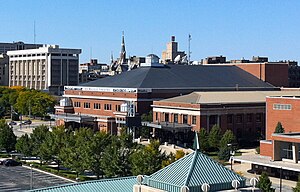Miller High Life Theatre
 |
|
| Former names | Milwaukee Auditorium (1909-2003) Milwaukee Theatre (2003-2017) |
|---|---|
| Address | 500 West Kilbourn Avenue Milwaukee United States |
| Coordinates | 43°02′30″N 87°55′03″W / 43.041759°N 87.917404°W |
| Owner | Wisconsin Center District |
| Operator | Wisconsin Center District |
| Capacity | 4,086 |
| Opened | 1909 |
| Website | |
| www |
|
Miller High Life Theatre (previously Milwaukee Theatre and originally Milwaukee Auditorium) is a theatre located in Milwaukee, Wisconsin. The building was extensively renovated between 2001-2003, at which point its name changed to the Milwaukee Theatre. A naming rights deal changed its name in 2017 to the Miller High Life Theatre. It seats 4,086 people and can be configured into a more intimate venue that seats 2,500. It is located at 500 W. Kilbourn Avenue in downtown Milwaukee.
The Milwaukee Auditorium was built in 1909, in a place formerly occupied by the Milwaukee Industrial Exposition Building, which had been destroyed by fire in 1905. The Milwaukee Auditorium held 13,520 people, and had 104,952 square feet (9,750.4 m2) of exhibition space. The cornerstone was laid on August 1, 1908, and the building was dedicated on September 21, 1909. At that time philanthropist Elizabeth Plankinton donated a $10,000 pipe organ.
Historical uses included concerts, circuses, political rallies and sports events. For decades the Milwaukee Auditorium boasted its own orchestra, and hosted touring concerts from such historic notables as John Phillip Sousa and Enrico Caruso to contemporary stars like Barry Manilow, Nirvana, Marilyn Manson and Prince. Sitting Presidents from Taft to Clinton delivered important policy addresses in the Auditorium. On October 14, 1912, former president and then current presidential candidate Theodore Roosevelt delivered a speech at the Milwaukee Auditorium shortly after a failed assassination attempt that left him with a bullet in his chest. He was shot across the street from the Auditorium at the Gilpatrick Hotel by John Schrank, but declined to go to the hospital before giving his speech.
Structural and cosmetic improvements were made throughout the Auditorium’s life, both before and after a major 1978 renovation brought in modern heating and air conditioning, restored architectural details and overall physical upgrades. However, by the time it was acquired by the new Wisconsin Center District in 1995, the Auditorium’s continued viability was questioned – until a 20-day run of Riverdance, in 1999, shattered sales records and indicated that a market existed for a venue of its size.
Beginning in October 2001, the Auditorium was converted into a theater. The project, which cost $41.9 million, was completed on November 7, 2003.
...
Wikipedia
